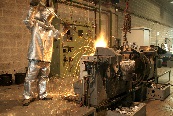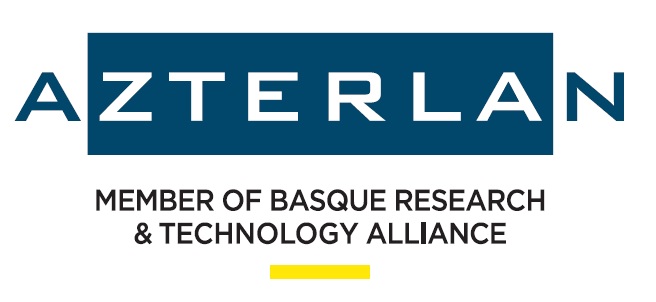NAME Eraldaketarako unitate aurreratua material eta galdaketa teknologia berriak garatzeko maila erdi-industrialean

Eraldaketaren unitate aurreratuak, konposizioaren doikuntzarako, metal likidoen tratamendurako, harea edo metalezko moldeen galdaketarako, hutsean eta/edo babes-atmosferarako galdaketarako eta solidotze-kontrolerako beharrezko ekipamendu guztiak ditu. Aleazio berriek beren errendimendu handia erakusten dute proben karakterizazioen bidez. Fe, Al, Cu eta/edo Ni-n oinarritutako edozein metal-aleazioren erakusleak eta prototipoak ere fabrikatzen dira; 3D diseinutik abiatuz eta piezak galdatu, termikoki tratatu eta/edo mekanizatuan emanez.
FIELDS OF APPLICATION
Advanced unions
Coatings and Surfaces solutions
Design and development of materials
Manufacturing processes
Materials and processes in Circular Economy
MOST OUTSTANDING EQUIPMENT AND COMPONENTS
-
Ablation/Hydrosolidification Unit
Equipment for manufacturing water-soluble sand cores and/or molds. The ablation cell is equipped with various nozzles which allow directing and significantly accelerating the solidification velocity and thus the microstructure. The equipment is applicable for all types of metal alloys.
-
Auxiliary equipment for liquid melt treatment, quality control, and pouring
Porous plug and rotating rotor (FDU) with deflector plate for deoxidation and degassing in liquid state. Vacuum equipment to facilitate the filling of molds or reduce gas entrapment.
-
Heat treatment furnaces and cryogenic chamber (various environments and monitoring parameters)
- Cryogenic chamber up to load of 600 kg with cycles between -196°C and +200°C.
- 4 furnaces for heat treatments from room temperatures up to 1500°C: different variants with vertical air circulation or forced air, with overpressure cooling, suitable for cycling up to 800°C; or air circulation under a protective atmosphere up to 1500°C.
- equipment for temperature profile measurement in heat furnace units with difficult accessibility using telemetry (Datapaq TB4270) with 10 Type K channels up to 1300°C.
- Sealed chambers for use in heat treatments in a controlled atmosphere. -
Melting furnaces for -Fe, -Al,-Cu and/or- Ni base alloys
100 kg medium-frequency melting furnaces for cast iron and steel, 2-40 kg electric melting furnaces for aluminum alloy, and a melting furnace with vacuum control and protective atmosphere with 20 kg of capacity for steels, Ni-base superalloys, etc.)
-
Quality Control Equipment
The quality of cast alloys is ensured through chemical composition analysis (spark spectrometer, ICP, portable X-ray, etc.) and metallurgical controls such as Thermolan® tests, Macroinclusion Test, D80, Alu-Q, etc. Stereographic Microscope, optical microscopy, and scanning electron microscopy (SEM).
SERVICES OFFERED BY THE ASSET
Development and validation of new base Fe-, Al-, Cu-, Ni-based metal alloys
New alloys are designed, produced, and validated by combining customer specifications, literature review, thermochemical simulation results, and the research team's know-how. Test components are available for melting and casting of new alloys under optimal conditions, enabling the validation of their high performance
Development of new casting technologies
New casting technologies are designed, developed, and validated by means of metal quality improvement, mold optimization, and the improvement of the production process itself—either accelerating or slowing down the solidification rate—to achieve optimal microstructures and component performance. Heat treatments are also included if required.
Manufacturing of lightweight components and/or high benefits by hyidrosolidification/ablation
Design of strategies for component lightweighting, starting from the initial design phase, load and strength calculations, through to prototype manufacturing and final characterization—both in terms of component quality and the required functionality. Supply options include as-cast condition, coated, heat-treated, and/or machined.
Manufacturing of wear resistance components
Design of strategies to improve the wear resistance of components or specific localized areas. These strategies are applicable from the component design stage to optimize wear performance, through prototype manufacturing and final characterization, including rapid prototyping solutions.
Optimization of valuation processes and recycling of critical metals
Design of recovery and recycling processes aimed at maximizing the waste materials valorization. Optimization of valorization processes through melting, chemical and/or electrochemical treatments, electrokinetic processes, as well as thermal and/or mechanical recovery methods—particularly focused on critical materials. Issuance of material, performance, and environmental certificates.
ENTITY MANAGING THE ASSET

Contact person:
Jon Garay
jgaray@azterlan.es